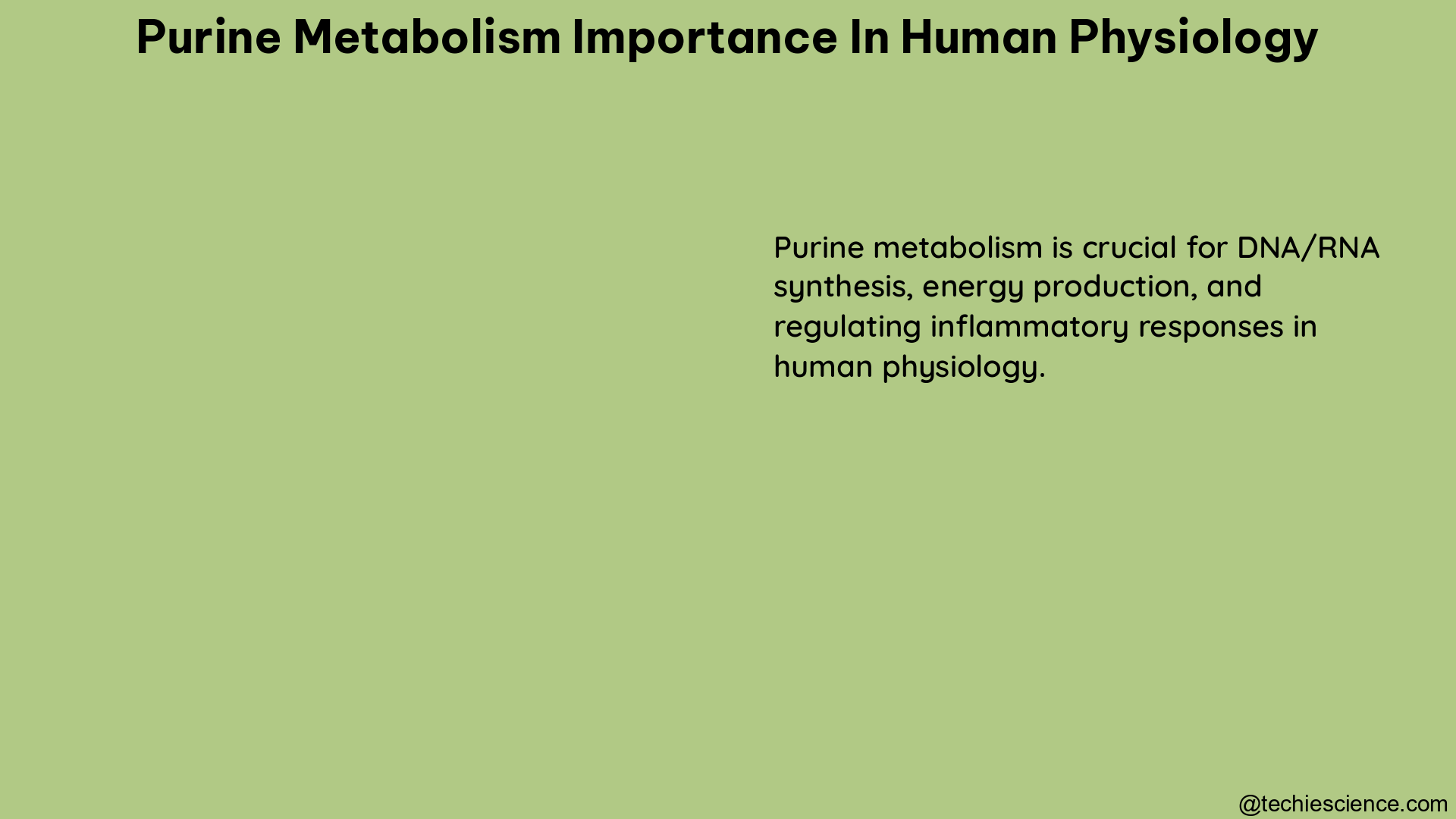Purine metabolism is a fundamental process that underpins numerous critical functions in the human body. From energy production to cellular signaling and DNA/RNA synthesis, the intricate dance of purine nucleotides and their metabolites is essential for maintaining optimal physiological homeostasis. This comprehensive guide delves into the multifaceted importance of purine metabolism in human physiology, equipping you with a deep understanding of this pivotal biochemical pathway.
The Energetic Powerhouse: Purine Metabolism and Energy Production
Purine nucleotides, such as adenosine triphosphate (ATP) and guanosine triphosphate (GTP), are the primary energy currencies of the cell. These high-energy molecules are generated through the intricate pathways of purine metabolism, fueling a vast array of cellular processes. In the heart, for instance, purine metabolism is intimately linked to the normal flow of energy, ensuring the efficient contraction and relaxation of cardiac muscle. Disruptions in this delicate balance have been strongly associated with the development of heart failure (HF), a debilitating cardiovascular condition.
Purine Metabolism and Heart Failure
Studies on patients with dilated cardiomyopathy (DCM), a form of HF, have revealed significant reprogramming of purine metabolism. Differential expression analysis has identified key metabolites, such as guanine, urea, and xanthine, as being significantly altered in DCM patients with HF. Furthermore, the identification of hub markers, including IMPDH1, ENTPD2, AK7, AK2, and CANT1, has provided valuable insights into the intricate regulatory networks governing purine metabolism in the context of heart disease.
Table 1: Differentially Expressed Metabolites in Dilated Cardiomyopathy with Heart Failure
| Metabolite | Significance |
|---|---|
| Guanine | Significantly detected |
| Urea | Significantly detected |
| Xanthine | Significantly detected |
These findings underscore the critical role of purine metabolism in maintaining cardiac function and highlight the potential for targeted interventions to address the metabolic derangements associated with HF.
Purine Metabolism and Metabolic Diseases

The importance of purine metabolism extends beyond the cardiovascular system, with significant implications in the realm of metabolic diseases. In the case of obesity-related insulin resistance, the activity of xanthine oxidoreductase (XOR), a key enzyme in purine catabolism, has been found to be much lower in human adipose tissue compared to mouse adipose tissue and the liver.
This observation suggests that human adipose tissue can serve as a source of hypoxanthine, a substrate for XOR, but not as a significant source of XOR itself within the purine catabolism pathway. This metabolic distinction highlights the need for a deeper understanding of the nuances in purine metabolism between different species and tissues, as it may hold the key to unraveling the complex mechanisms underlying obesity-related insulin resistance.
Accurate Measurement of Purine Metabolites
Precise quantification of purine metabolites, such as xanthine and hypoxanthine, is crucial for understanding their physiological roles and potential diagnostic applications. However, the time between blood collection and plasma separation can significantly affect the concentrations of these metabolites due to their potential leakage from erythrocytes.
To address this challenge, a commercially available blood collection tube has been reported to enable accurate measurements of hypoxanthine and xanthine, regardless of the time until plasma separation. This technological advancement ensures the reliability and reproducibility of purine metabolite analysis, paving the way for more robust clinical investigations and personalized healthcare approaches.
Purine Metabolism and Cellular Signaling
Beyond energy production, purine nucleotides and their metabolites play a pivotal role in intracellular signaling pathways. Adenosine, a purine derivative, acts as a potent signaling molecule, regulating diverse physiological processes, such as vasodilation, neurotransmission, and immune function. Disruptions in adenosine signaling have been linked to various pathological conditions, including cardiovascular diseases, neurological disorders, and inflammatory conditions.
Guanine nucleotides, on the other hand, serve as essential components of G-protein-coupled receptor (GPCR) signaling, a ubiquitous and versatile cellular communication system. The interconversion of guanine nucleotides, such as GTP and GDP, is tightly regulated and crucial for the proper functioning of GPCR-mediated signaling cascades, which are involved in a wide range of physiological processes, from sensory perception to hormone regulation.
Purine Metabolism and Nucleic Acid Synthesis
Purine nucleotides are not only energy carriers but also essential building blocks for the synthesis of DNA and RNA. The de novo purine biosynthesis pathway, which generates inosine monophosphate (IMP) as a key intermediate, is a highly regulated process that ensures the adequate supply of purine nucleotides for nucleic acid synthesis.
Disruptions in this pathway can lead to various genetic disorders, such as Lesch-Nyhan syndrome, a rare inherited condition characterized by neurological and behavioral abnormalities, as well as the overproduction of uric acid, a purine metabolite.
Purine Metabolism and Immune Function
Purine metabolism also plays a crucial role in the regulation of immune function. Adenosine, for instance, acts as an immunomodulator, influencing the activity of various immune cells, such as T cells, B cells, and natural killer cells. Elevated levels of adenosine have been associated with the suppression of immune responses, which can have implications in the context of cancer, autoimmune diseases, and chronic inflammatory conditions.
Furthermore, the purine metabolite uric acid, when present in excess, can trigger the formation of crystals that lead to the inflammatory condition known as gout. This underscores the delicate balance required in purine metabolism to maintain optimal immune homeostasis.
Conclusion
Purine metabolism is a multifaceted and intricate process that underpins numerous critical functions in human physiology. From energy production and cellular signaling to nucleic acid synthesis and immune regulation, the intricate dance of purine nucleotides and their metabolites is essential for maintaining overall physiological homeostasis.
By understanding the pivotal role of purine metabolism in the human body, we can unlock new avenues for the diagnosis, prevention, and treatment of a wide range of diseases, ranging from cardiovascular disorders to metabolic conditions and beyond. This comprehensive guide has provided a deep dive into the importance of purine metabolism, equipping you with the knowledge to appreciate the remarkable complexity and significance of this fundamental biochemical pathway.
References
- A New View into the Regulation of Purine Metabolism – NCBI: https://www.ncbi.nlm.nih.gov/pmc/articles/PMC5272809/
- A circular network of purine metabolism as coregulators of dilated cardiomyopathy – NCBI: https://www.ncbi.nlm.nih.gov/pmc/articles/PMC9673417/
- New insights into purine metabolism in metabolic diseases – Journal of Physiology: https://journals.physiology.org/doi/full/10.1152/ajpendo.00378.2020
- Purine Metabolism – an overview | ScienceDirect Topics: https://www.sciencedirect.com/topics/medicine-and-dentistry/purine-metabolism

I am Abdullah Arsalan , Completed my PhD in Biotechnology. I have 7 years of research experience. I have published 6 papers so far in the journals of international repute with an average impact factor of 4.5 and few more are in consideration. I have presented research papers in various national and international conferences. My subject area of interest is biotechnology and biochemistry with special emphasis on Protein chemistry, enzymology, immunology, biophysical techniques and molecular biology.